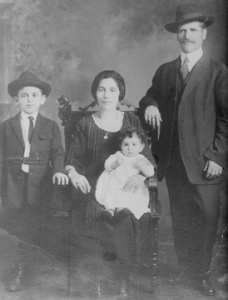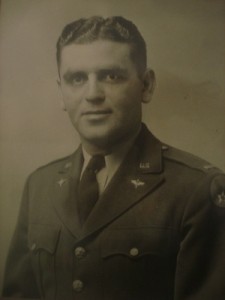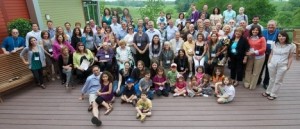
Lara’s Western PA family in 1922
I’m excited to present this week’s featured user, Lara Diamond, because finding her through Treelines was my first “Treelines moment,” or connection with an unrelated genealogist whose similar family background means that her stories add context to complement mine. She’s a longtime genealogist, though a new genealogy blogger, and we had fun diving into each other’s family history. Here are some highlights from our conversation:
Tammy: When we first got to talking we discovered we have a lot in common. We’re about the same age, both researching our Jewish ancestors who came here from Hungary and Ukraine, and our Hungarian ancestors even settled in neighboring small towns around Pittsburgh. But what really struck me when I first read your two stories was that we must really be on the same genealogical wavelength to have chosen the same stories to tell first — the stories of how our ancestors immigrated here. What was it for you about these stories that you gravitated to them first?

Isadore Joshowitz during WWII
Lara: As I’m recording names & dates, I always wonder about the people behind the data. Particularly for those parts of my family that came in the early 1900s, it must have been a huge leap of faith. During a time when trans-Atlantic phone calls couldn’t have been imagined, let alone FaceTime or even email, they left behind family members and the only lives they ever knew to go to America. And despite moving to a country with a new language and culture, they and their descendents thrived.
Tammy: One of the reasons why I focus on my family’s immigration stories is that transition of becoming American — all those little adaptions, either intentional or subconscious, that help them to cope and fit in. I wonder if they realized how quickly and completely they would change.
Lara: It’s actually interesting to see how they adapted in some ways, but other things stayed very much the same. I have some ancestors who became very American and others who recreated the best of what they had in Europe while enjoying the safety and freedom that was part of being American.
Tammy: From the two stories you’ve shared so far, your American family is moving between small towns and cities. How do you think small-town life shaped your family’s sense of themselves as new Americans?
Lara: My mom’s maternal grandparents went to McKeesport (he sold fruit from a truck), and her paternal grandparents went to Pittsburgh (he was in the cigar business). My grandparents’ marriage was considered a “mixed” marriage–a Russian Jew from Pittsburgh married a Hungarian Jew from McKeesport!
On my father’s side, my grandparents were Holocaust survivors who moved to a not-so-nice part of Baltimore. They started their own grocery business with the help of relatives already in Baltimore and eventually ended up in a nicer area. My grandfather’s grandfather had immigrated to America earlier, and he lived on a farm in a very rural part of Maryland (Annapolis Junction). He took the train into Baltimore daily to sell eggs from the farm and attend a synagogue. Eventually he moved to Baltimore where he could be near the larger Jewish community.
Tammy: I guess this means my father’s parents’ marriage was also “mixed” — Hungarian Jew from Homestead marrying Russian Jew from Pittsburgh — though both were American-born, so perhaps it impacted them less.
That grandfather was quite a cigar smoker — perhaps he was a customer of your Pittsburgh forebears! Which brings me to the main question I have for you, which is what anecdotes survive in your family about life in McKeesport? To me, this is the the “Treelines moment” — connecting with someone you might not have known otherwise to compare stories about similar, though unrelated families in similar circumstances.
Lara: My grandmother often told the story of when her father was paid by someone with a chicken. This was in the middle of the Depression, so the family seldom had meat. My grandmother was sent by her mother to take the chicken by streetcar to the butcher. My grandmother had the chicken in a covered basket and got on the streetcar–only to see some kids from school. She was so embarrassed to be carrying a chicken, so she pushed its head back into the basket and hoped no one saw. It pushed its head out. She pushed it back in. After a couple of iterations, she was relieved that the chicken had been taught its lesson, and the other kids didn’t seem to have noticed. But when she got to the butcher, she discovered that she’d actually killed the chicken by teaching it the lesson a bit too strongly!
At this point we started exchanging juicy family stories that were a bit more sensitive, but we concluded our conversation talking about Treelines itself.
Tammy: So, more important than the connection that we found through your family stories, how did your family enjoy reading them?

Suttleman family reunion, 2011
Lara: Treelines is a great way to share family stories I’ve discovered through my research with family members who aren’t as excited as I am by the research process. When I sent out links to my Treelines stories, I got effusive and excited replies from relatives who never really cared about seeing an ancestor’s boat record. Treelines’ way of showing them the whole story reached them in a way that dry documents couldn’t. I love reading other users’ Treelines contributions to find others with similar family stories–as well as those with entirely different backgrounds.
I’ve started to document my research process on a blog, which forces me to examine where I am on various lines and revisit gaps to see if I can fill them. There is so much you can learn about ancestors through old documents. Once a story is complete (or as complete as I can make it), it’s a perfect point to pull it together on Treelines.
 Follow
Follow